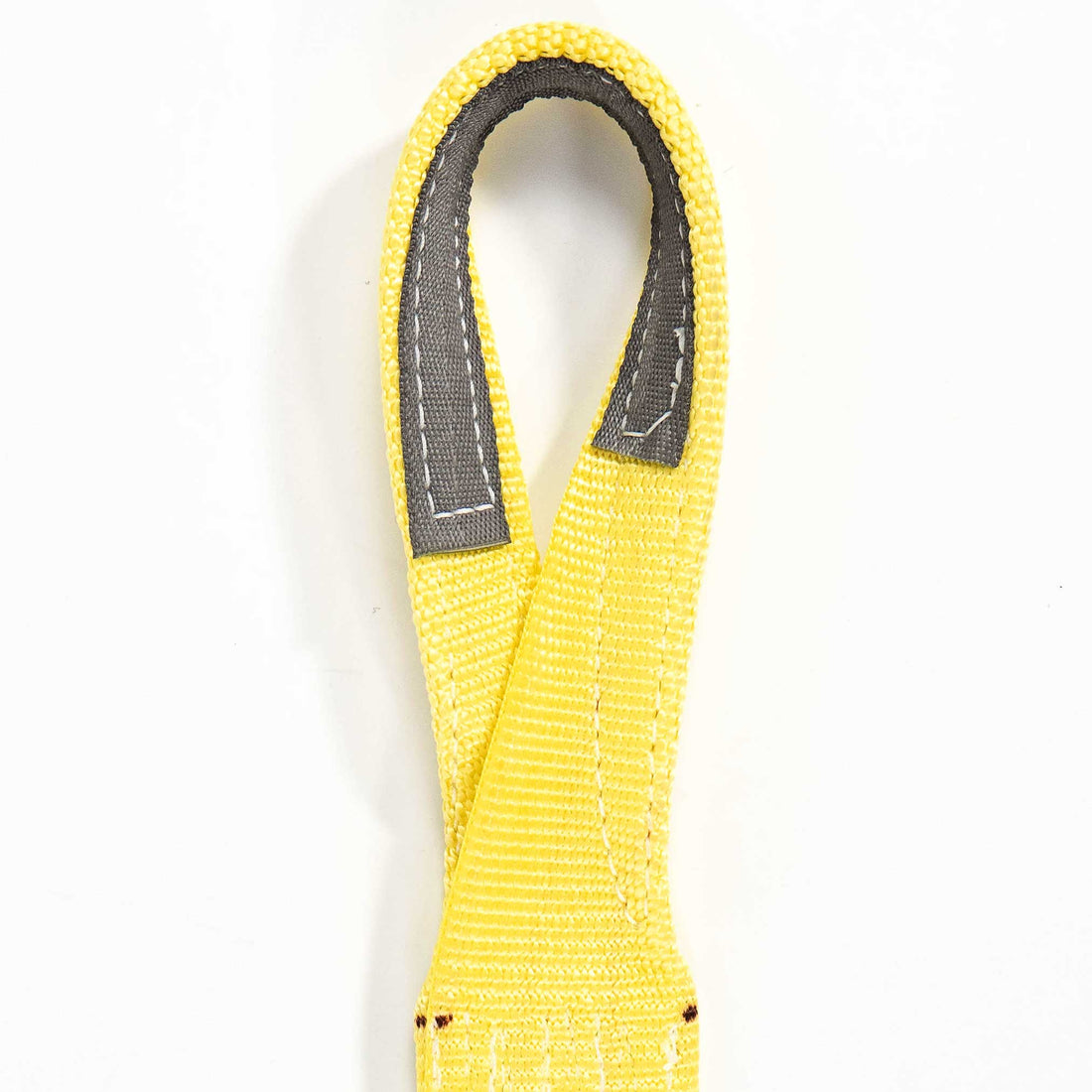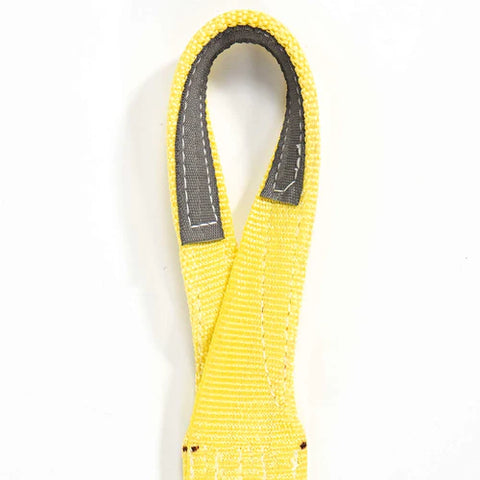
Nylon Lifting Slings 101

Nylon lifting slings are a staple in the rigging and lifting industry, combining strength with flexibility.
Jump to the Information You Need
- Sling Lifting Techniques
- Nylon Sling Capacity Chart
- What is a Nylon Lifting Sling?
- Why Choose a Nylon Lifting Sling?
- Lifting Sling Material
- Nylon Sling Inspection
- Nylon Sling Protection
- How to Measure a Nylon Lifting Sling
View / Download This Article as a PDF
What is a Nylon Lifting Sling?
Nylon lifting slings are used in the lifting and rigging industry. They transport everything from drums to building materials. Made from heavy-duty industrial-grade webbing, our slings can hold up in even the most rigorous applications.
Many of our slings are made in the USA and come with a tag that includes the working load limits for various hitches for ease of use.
Nylon slings are popular because they are versatile and can be used in almost any type of lift.
Types of Nylon Lifting Straps
There are multiple variations when it comes to our nylon lifting straps designs. This makes it easy for you to choose the one best-suited to your application.
Once you've identified the most compatible style (explored further below), then you will need to find the right combination of width, length, and plies. For example, a 3- or 4-ply nylon lifting strap offers greater strength at smaller widths but is less flexible than a 1- or 2-ply option.
Some slings are even available with built-in wear pads for abrasion-resistance.
Type 1 – Triangle Choker Sling
Nylon triangle choker lifting slings have a steel triangle on each eye – one of which includes a slot. The smaller triangle can pass through this slot to create the necessary setup for a choker hitch.
The metal end fittings extend the working lifespan of the sling by reducing wear and tear on the eyes.
Hitch types: Choker, vertical, basket
Type 2 – Triangle Sling
The type 2 triangle slings are incredibly similar to the type 1 sling, except that they cannot be used in choker hitches. Unlike the type 1 nylon lifting sling, neither of the triangle end fittings includes a slot.
Hitch types: Vertical, basket
Type 3 – Flat Eye & Eye
Flat eye and eye slings have eyes with no end fittings. The eye design makes them easier to remove from beneath a load than those with end fittings or a twisted eye. They are very versatile and are one of our most popular slings.
Hitch types: Choker, vertical, basket
Type 4 – Flat Eye & Eye Twist
The construction of the twisted eye and eye sling is almost identical to the type 3 sling, except for the eyes. The loops are twisted, which allows for superior performance in basket and choker hitches.
Hitch types: Choker, vertical, basket
Type 5 – Endless Sling
Endless slings are a loop – the ends of the nylon lifting strap are joined together using a load-bearing splice. The main benefit of this style is that you can adjust the contact points with each lift, reducing the wear and tear on the fabric.
Hitch types: Choker, vertical, basket
Type 6 – Reverse Eye Sling
The type 6 slings are known as a reverse eye sling. Equal to one half the body width of the sling, these eyes stand at 90 degrees to the sling body, a setup that prevents twisting during lifts with a basket or choker hitch. The eyes also reverse, doubling the service life.
This style works better than flat eye slings in a choker hitch and is covered with Cordura® wear pads, a thick, durable fabric that resists abrasion.
Hitch types: Choker, vertical, basket
Type 7 – Flat Eye Sling
Flat eye type 7 slings are the same as the type 6 sling, but with flat eyes.
Hitch types: Choker, vertical, basket
Type 8 – Continuous Eye Wide
Continuous eye slings are ideal for heavy loads. The wide body provides extra stability, and the eye design provides extra strength. They are a continuous part of the sling, rather than an attachment.
These nylon lifting straps can be up to 24" - this added width can even protect fragile cargo during a lift.
Hitch types: Basket
Type 9 – Attached Eye Wide
Similar to type 8 slings, type 9 attached eye slings have a wide body for additional stability. Because the eyes are attached, however; these are not as strong.
Their eyes are narrow to accommodate smaller hooks.
Hitch types: Basket
Bridle Slings
Bridle slings come with a master link on one end and a variety of end fittings (including a standard eye) on the other.
They can have up to four legs, making them the ideal choice for lifts with more than one pickup point, and provide a lighter alternative to chain or wire rope slings.
Learn more about our nylon bridle slings
Drum Slings
Our drum slings work well when used with 55-gallon drums. They attach using either a harness or hooks, and used mostly in warehouses or manufacturing facilities.
Learn more about the different kinds of nylon slings in the video below:
Why Choose a Nylon Sling for Lifting?
Nylon is the most widely used sling fabric. It has many benefits – it's relatively inexpensive and is flexible, which prevents it from locking up on a load.
This flexibility also makes it a good option for fragile or irregularly-shaped loads. Nylon will conform to the shape of the object, creating a stable lifting setup.
It's unaffected by oil and grease and resistant to aldehydes, ethers, and strong alkalis. It shouldn't be used, however, with bleaching agents or acids.
Some other important factors to keep in mind is that nylon stretches approximately 8-10% at rated capacity and should only be used in temperatures under 194 degrees Fahrenheit (90 degrees Celsius).
Benefits of Nylon as a Lifting Sling Material
Comparing nylon to a couple of the more popular alternatives can help you choose which one will work for you.
Polyester vs Nylon
Polyester is very similar to nylon but only stretches 3-5% at rated capacity, making it a better choice for low headroom applications. It also differs in the types of chemicals it can be exposed to: polyester is impervious to bleaching agents and acids but cannot handle sulfuric acids or alkaline.
It has the same upper temperature limit as nylon.
Wire Rope vs Nylon
Wire rope is not as flexible or as easy-to-use as nylon, but it provides superior strength and resilience to high temperatures. If you want a tougher sling than nylon without spending as much as you would on chain, wire rope is a good option.
Chain vs Nylon
Chain is expensive but durable – resistant to cutting and abrasions, it's a great choice for situations where nylon slings would fail. It can also handle temperatures up to 400 degrees Fahrenheit (204 degrees Celsius).
Chain is much heavier than a nylon sling, which can affect transport and storage considerations.
Learn more about the different factors to consider when choosing a sling
Nylon Sling Lifting Techniques
There are three primary hitches when using nylon slings: vertical, choker, and basket.

A vertical hitch is where the load attaches to the bottom of the sling, either to the eye or to end hardware.


Basket hitches have both eyes attached overhead, cradling the load.
Due to the differences in the strap set ups, each has a different working load limit.
Nylon Sling Capacity Chart
|
|
Percent of WLL |
Example |
|
Vertical |
100% |
1,500 lbs. |
|
Choker |
75-80% |
1,200 lbs. |
|
Basket |
200% |
3,000 lbs. |
Note these are the standard values and can vary based on the sling you purchase. Check the hitch working load limits provided before purchasing. The above chart is contingent on the sling being at a 90 degree angle.
How to Measure a Nylon Lifting Strap
To determine the length of your sling, you will need to measure from the load-bearing point of one eye or fitting to the load-bearing point of the other eye or fitting.
This applies even to endless lifting slings – to find the length, stretch the sling from end to end and measure from tip to tip. Do not measure the circumference.

Nylon Webbing Sling Protection
"Slings in contact with edges, corners, protrusions, or abrasive surfaces shall be protected with a material of sufficient strength, thickness, and construction to prevent damage." - ASME B30.9 (2021) 9-5.10.4(d)
Sling protection is essential for your rigging and lifting application. Not only can it protect your sling from lift-related damage (extending the life of the sling), but it also makes your jobsite safer.
While it's important to use sling protection for all lifts, nylon lifting slings are more likely to incur damage than slings made from most other materials – they can be cut, torn, or abraded by the load. This can have dangerous consequences: the number one cause of sling accidents is the cutting of synthetic slings.
Where is Sling Protection Needed?
Sling protection for nylon lifting straps should be present at any point the sling is making or could make contact with the load or hardware. This includes lift points, the top connection point, and even load edges that are above the hookup points!
Learn more about sling protection available at US Cargo Control
Nylon Lifting Sling Inspection
Your nylon lifting sling should be inspected by a designated person to look for any damage or other signs that the sling should be removed from service.
Removal criteria include illegible sling identification, excessive dirt in the rope structure, discoloration that can indicate chemical or heat damage, and more.
Make sure you are up-to-date on the ASME B30.9-4.9 inspection, removal, and repair guidelines when using a nylon sling.



